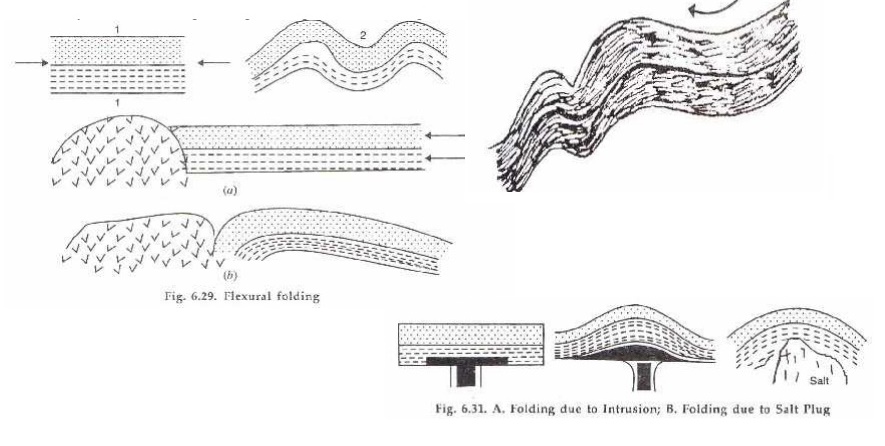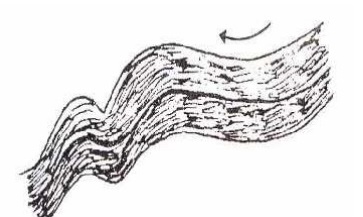Chapter: Civil : Engineering Geology : Structural Geology And Geophysical Method
Causes Of Folding

CAUSES OF FOLDING
The
Tectonic Folding may be due to any one or more of the following mechanisms:
Folding
Due to Tangential Compression
Lateral Compression is believed to be the main cause for
throwing the rocks of the crust into different types of folds depending upon
the types of rocks involved in the process and also the direction and magnitude
of the compression effecting those rocks.
In general, this primary force is
believed to act at right angles to the trend of folds. under the influence of
the tangential stresses, folding may develop in either of the three ways:
flexural folding, flowage folding and shear folding.

Flexural
Folding.
It is that process of folding in
which the competent or stronger rocks are thrown into folds due to their
sliding against each other under the influence of lateral compression.
This is also distinguished as flexural-slip-folding in which
the slip o r movement of the strata involved takes place parallel to the
bedding planes of the layers.
It has been establis hed that in flexural folding,
the amount of slip (and hence the ultimate type of fold) depends on a number of
factors such as:
thickness o f the layers and nature of the
contact; thick er the layers, greater is the slip; further, cohesionless
contacts favour easy and greater slips;
![]()
distance fr om the hinge point; greater the
distance from the hinge points, larger is the
![]()
displacement,
so much so that it may be negligible at the hin ge point;
![]()
type of the rocks involved; siltstones, sandstones
and li mestones are more prone t o flexure slip folding compared to soft clays
and shales.
![]()
Flowage Folding
Ø It is t
he principal process of folding in incompetent or weaker, plasti c type of
rocks such as clays, shales, gypsum an d rock salt etc.
Ø Duri ng
the compression, the material of the involved layers behaves almost as a
viscous or plastic mass and gets buckled up and d eformed at varying rates
suffering unequal disto rtion.
Ø In such
cases the thickness of the resulting fold does not remain unifor m.

Shear Folding.
Ø In many
cases, folding is attributed to shearing stresses rather than simple
compression.
Ø It is
assumed that in such a process, numerous closely spaced fractures develop in
the rock at the first stage of the process.
Ø This is
followed by displacement of the blocks so developed by different amounts so
that ultimately the rocks take up folded or bent configuration.
Ø The
folded outline becomes more conspicuous when the minor fractures get sealed up
due to subsequent recrystallisation.
Folding Due to lnsrusions
Ø Intrusion
of magma or even rock salt bodies from beneath has been found to be the cause
of uparching of the overlying strata.
Ø In
magmatic intrusions, highly viscous magma may be forced up very gradually and
with considerable force so that the overlying sedimentary host rocks are bodily
lifted up to provide space for the rising magma.
Ø In
extreme cases, the magma may even rupture the overlying strata to flow out as
lava

Folding Due to Differential Compression
Ø Strata
that are being compacted under load in a basin of sedimentation develop, with
passage of time, downward bending especially in the zones of maximum loading.
Ø If the
strata in question is not homogeneous, the bending may not be uniform in
character and results in warping or folding of different types.
Ø Such
folds are, however, totally dependent on the load from above and are attributed
to superficial causes.
Ø These
are, therefore, non- tectonic folds.
ENGINEERING CONSIDERATIONS
Ø Folds
developed in the areas of work are important for a civil engineer in that these
make his work more complicated.
Ø If these
structures are not thoroughly investigated and properly interpreted, any civil
engineering project standing on or driven through the folded rocks may prove
not only uneconomical in the ultimate analysis but also, unsafe as well.
Ø Due
consideration is, therefore, always to be given to the presence of folds in
deciding about the designing and construction of such structures as driving of
traffic and hydropower tunnels, selection of sites for dams and reservoirs and
in fixing the alignments of roads, bridges and highways.
Change in Attitude
1 Folding of any type would cause a change in
the attitude (dip and strike) of the same strata in the aerial extent and also
in depth.
2 Hence
same layers may be repeated along an alignment or one or more different layers
may be unexpectedly encountered.
3 If it
happens so and the unexpectedly repeated or encountered layers are of undesirable
nature, the project costs may be effected as also the time schedule and safety
of the project.
Shattering
of Rocks.
1 The
stresses are often strong enough to break or shatter the rocks, especially in
the axial zones, which are the places of maximum concentration of these forces.
2 hence, in
folded rocks, axial regions are likely to be the areas containing fractured
zones.
3
This effect is of utmost importance because
shattered rocks become:
• weak in
strength parameters of all types;
• porous
and pervious in character;
Axial regions in the folded rocks should be thoroughly studied
and if possible, should be avoided for other better alignments or sites as the
case may be.
If it is not possible to avoid them, these areas must be
subjected to suitable processes of rock treatment for developing in them
desired qualities of strength and imperviousness.
Strained
Nature.
1 All the
stresses that have acted on the rocks during their folding are generally
absorbed by these rocks by undergoing strain.
2 In essence,
the folded rocks are considerably strained, the magnitude of strain varying
from point to point in the folded sequence.
3 Now, as
and when there is an effort by nature or by the engineer to disturb this
adjustment of the rocks to the stresses, the rock may respond by release of
some strain energy.
4 Enough
stored strain energy is released as soon as (or soon after) the excavations are
made and huge blocks of rocks start caving in or falling with great force
called the rock bursts.
5 This
often involves fatal accidents besides causing considerable delay in the
progress of the work.
6 A proper
planning of the work in folded areas is, therefore, of utmost importance to
avoid these possible hazards in construction work.
Related Topics